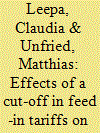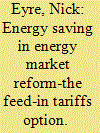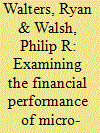|
|
|
Sort Order |
|
|
|
Items / Page
|
|
|
|
|
|
|
| Srl | Item |
| 1 |
ID:
117252


|
|
|
|
|
| Publication |
2013.
|
| Summary/Abstract |
In the last two decades, feed-in tariffs (FIT) have emerged as one of the most popular policies for supporting renewable electricity (RES-E) generation. A few studies have assessed the effectiveness of RES-E policies, but most ignore policy design features and market characteristics (e.g. electricity price and production cost) that influence policy strength. We employ 1992-2008 panel data to conduct the first econometric analysis of the effectiveness of FIT policies in promoting solar photovoltaic (PV) and onshore wind power development in 26 European Union countries. We develop a new indicator for FIT strength that captures variability in tariff size, contract duration, digression rate, and electricity price and production cost to estimate the resulting return on investment. We regress this indicator on added RES-E capacity using a fixed effects specification and find that FIT policies have driven solar PV development in the EU. However, this effect is overstated without controlling for country characteristics and is concealed without accounting for policy design. We do not find robust evidence that FIT policies have driven wind power development. Overall, we show that the interaction of policy design, electricity price, and electricity production cost is a more important determinant of RES-E development than policy enactment alone.
|
|
|
|
|
|
|
|
|
|
|
|
|
|
|
|
| 2 |
ID:
110750


|
|
|
|
|
| Publication |
2011.
|
| Summary/Abstract |
Due to Taiwan's lack of natural resources, dependence on imported energy, and pursuit of sustainable development, renewable energies are extremely important for Taiwan's future energy supply. Since Taiwan's feed-in tariff (FIT) is still in its initial stage, one must examine whether the current system is compatible with a well-designed FIT scheme. This study examines the main features of Taiwan's FIT system and assesses design options using several criteria. Additionally, one of the most important elements of a FIT scheme, namely, a tariff system, is discussed. Taiwan's FIT scheme has the design options required by well-functioning FITs, and the guaranteed-return tariff system coincides with the spirit underlying leading global FITs; however, many issues, such as setting goals by stages, refinement of the tariff calculation methodology, and elimination of other non-economic barriers, must be addressed to achieve future developmental goals and green industry growth.
|
|
|
|
|
|
|
|
|
|
|
|
|
|
|
|
| 3 |
ID:
116916


|
|
|
|
|
| Publication |
2012.
|
| Summary/Abstract |
Beginning in 2006, China experienced a rapid growth in its renewable energy resources, particularly wind power, placing it among the world's leading countries in terms of renewable energy installation and generation. This growth was greatly enabled by the renewable energy policy framework created by its landmark Renewable Energy Law, passed in 2005 and amended in 2009, which established key policies including: national renewable energy targets; a mandatory connection and purchase policy; a national feed-in tariff system; and arrangements for cost-sharing and funding of renewable energy incentives.
This paper describes the mechanisms established by the Renewable Energy Law and its implementing regulations, as well as the challenges China continues to face in improving its renewable energy policy framework to improve integration and utilization of renewable energy sources. It also provides a comparison of the Chinese renewable energy policy framework with those in the European Union and United States. Finally, the paper provides recommendations for improving implementation of the Renewable Energy Law, with regard to implementing a renewable power quota system and priority dispatch policy, developing technical standards for connection of renewable resources with the grid, development of a more advanced feed-in tariff system, and central-local coordination of renewable energy development.
|
|
|
|
|
|
|
|
|
|
|
|
|
|
|
|
| 4 |
ID:
099304


|
|
|
|
|
| Publication |
2010.
|
| Summary/Abstract |
China has recently become a dominant player in the solar photovoltaic (PV) industry, producing more than one-third of the global supply of solar cells in 2008. However, as of 2008, less than 1% of global installations were based in China. Recently, the government has stated its grand ambitions of expanding the share of electricity derived from solar power. As part of this initiative, policy makers are currently in the process of drafting a feed-in tariff policy to support the development of the solar energy market. In this paper, we aim to calculate what the level of such a tariff should be. We develop a closed form equation for the cost of PV, and use forecasts on prices of solar systems to derive an optimal feed-in tariff, including a digression rate. The focus is on the potential of residential and small scale commercial solar PV installations. We show that the cost of small scale PV in China has decreased rapidly during the period 2005-2009. Our analysis also shows that optimal feed-in tariffs vary widely between regions within China, and that grid parity could be reached in large parts of the country depending on the expected escalation in electricity prices.
|
|
|
|
|
|
|
|
|
|
|
|
|
|
|
|
| 5 |
ID:
115172


|
|
|
|
|
| Publication |
2012.
|
| Summary/Abstract |
Although wind power is currently the most efficient source of renewable energy, the cost of wind electricity still exceeds the market price. Subsidies in the form of feed-in tariffs (FIT) have been introduced in many countries to support the expansion of wind power. These tariffs are highly debated. Proponents say they are necessary to pave the way for decarbonising energy production. Opponents argue they prevent a welfare-optimal energy supply. Thus, in a case study we try to shed light on the welfare economic aspect of FIT by combining spatial modelling and economic valuation of landscape externalities of wind turbines. We show for the planning region West Saxony, Germany, that setting FIT in a welfare optimal manner is a challenging task. If set too high the production costs are overly increased, lowering social welfare. If set too low energy production targets may not be reached and/or external costs are overly increased, again lowering social welfare. Taking a closer look at the tariffs offered by the German Renewable Sources Energy Act we find for West Saxony that the tariffs quite well meet economic welfare considerations. One should note, however, that this finding might apply only to the present data set.
|
|
|
|
|
|
|
|
|
|
|
|
|
|
|
|
| 6 |
ID:
121309


|
|
|
|
|
| Publication |
2013.
|
| Summary/Abstract |
We analyze the effects of feed-in tariff (FIT) adjustments on installed photovoltaic capacity in Germany. We find that the current system temporarily accelerates installments and does not countervail over-investment. Therefore, we design three alternative FIT regimes: (i)constant FITs, (ii) linearly decreasing FITs, and (iii) FIT adjustments related to the changes of photovoltaic panel prices. Simulations of installed capacities indicate that alternative adjustment mechanisms could be more appropriate to meet the government's installation target. Moreover, we calculate the consumers' burden induced by the FITs and find that it might be reduced by alternative mechanisms.
|
|
|
|
|
|
|
|
|
|
|
|
|
|
|
|
| 7 |
ID:
109342


|
|
|
|
|
| Publication |
2011.
|
| Summary/Abstract |
Ireland's Renewable Energy Feed-In Tariff (REFIT) for wind generation has some unusual features making it different from other REFIT schemes around the world. By utilising an annual floor price element the scheme presents an option value to the contract holder, which to date has gone unnoticed or unvalued in the market. By employing an option pricing framework, this paper has quantified for the first time in the public domain the expected costs and value of the Irish REFIT support scheme for wind generation. While the cost of the REFIT scheme to the electricity consumer appears to be lower than the cost of schemes in other countries, significant inefficiencies exist as a result of the structure of the scheme. The Irish REFIT scheme is contrasted with a single Fixed Price support scheme and the analysis suggests that the Fixed Price scheme can provide a similar or greater incentive to the wind sector at half the cost to the end electricity consumer, and may also prove more compatible with consumers desire to reduce inter-year electricity portfolio cost volatility.
|
|
|
|
|
|
|
|
|
|
|
|
|
|
|
|
| 8 |
ID:
117237


|
|
|
|
|
| Publication |
2013.
|
| Summary/Abstract |
The use of feed-in tariffs (FITs) is now widespread for renewable energy and under discussion for other low carbon electricity generation, but not for energy efficiency. There is a small literature on FITs for electricity demand reduction, but not energy efficiency more generally. This paper considers the general application of FITs on the demand side and sets out the economic arguments in the context of changing energy markets. It then discusses the implications of some practical issues, including the definitional problems arising from the difference between energy efficiency and demand reduction. Using experience from historical energy efficiency programmes, it considers the public benefits, payment methods and policy scope that need to be considered and how these might affect policy design. It makes some provisional estimates of economically justified payments in the context of the proposed UK energy market reform. It concludes that FITs for energy saving might be a powerful tool for incentivising energy efficiency.
|
|
|
|
|
|
|
|
|
|
|
|
|
|
|
|
| 9 |
ID:
110737


|
|
|
|
|
| Publication |
2011.
|
| Summary/Abstract |
This paper examines solar energy development in Malaysia, particularly in relation to the installation of solar Photovoltaic (PV) in residential houses. It analyzes the past activities related to solar energy in Malaysia, in terms of research and developments (R&Ds), the implementations used as well as the national policies for the past 20 years which have pushed the installation of PV in the country. The Feed-In Tariff (FiT) scheme is discussed, showing comparative cost-benefit analysis between the PV installation in houses in the United Kingdom (UK) and Malaysia, and with other investment schemes available in Malaysia. To investigate the awareness of renewable energy policies and incentives, a preliminary survey of the public opinion in Malaysia has been carried out, and an evaluation of public willingness to invest in the FiT scheme by installing the PV on their houses is presented. The cost-benefit analysis shows that the proposed FiT programme is capable of generating good return on investment as compared to the one in the UK, but the return is lower than other investment tools. The survey suggests that most Malaysians are unaware of the government's incentives and policies towards renewable energies, and are not willing to invest in the FiT scheme.
|
|
|
|
|
|
|
|
|
|
|
|
|
|
|
|
| 10 |
ID:
109372


|
|
|
|
|
| Publication |
2011.
|
| Summary/Abstract |
This paper seeks to evaluate the effect of the upcoming 2010 UK Feed-in Tariff (UK FIT) on decentralised small wind-energy installations at the household and building level in urban locations. It is projected that the UK FIT will stimulate an unprecedented surge in building-mounted turbine installation. The tariff amount must stimulate incentive but mitigate the likelihood of distortions in the competitive electricity market. To analyse these issues, measured energy output from sites in the Warwick Wind Trials Project (WWTP) is converted into revenue in a net-present-value (NPV) framework for assessing commercial purchases of small wind systems. Variances in project variables are examined through NPV simulations using Monte Carlo analysis to capture permutations of small wind-project performance in the UK-with and without the UK FIT. Our research concludes that the proposed tariff amount of 30.5 p/kWh will not significantly boost the economic attractiveness of mildly selective (WWTP-based) sites in the UK. Furthermore, the fixed-tariff rate (£/kWh generated) could cause inefficiencies applied across uneven wind-resource distribution. The results of this study suggest further examination of policy related to micro-generation, in particular decentralised small wind projects.
|
|
|
|
|
|
|
|
|
|
|
|
|
|
|
|
| 11 |
ID:
097217


|
|
|
|
|
| Publication |
2010.
|
| Summary/Abstract |
Feed-in tariff (FIT) and tradable green certificate (TGC) schemes are studied in a formal model and numerical example using the UK data. We find that if the markets were perfectly competitive, then feed-in tariff and the certificate price would be the same. However, when the markets are imperfect, they are generally different. While both the tariff and certificate price fluctuate around the difference between the costs of green and black energy, the tariff deviates more from the cost difference than the certificate price. The supplies of both black and green energy under FIT are higher than TGC, obviously as a result of subsidies. A troubling outcome is that the total energy supply increases under FIT as the renewables quota increases, which can negate other measures to mitigate climate changes such as demand management. Finally, using the data from the UK market, we find that social welfare under TGC is consistently higher than FIT for a wide range of values of the parameters.
|
|
|
|
|
|
|
|
|
|
|
|
|
|
|
|
| 12 |
ID:
125555


|
|
|
|
|
| Publication |
2013.
|
| Summary/Abstract |
The advent of large samples of smart metering data allows policymakers to design Feed-in Tariffs which are more targeted and efficient. This paper presents a methodology which uses these data to design FITs for domestic scale grid-connected PV systems in Ireland. A sample of 2551 household electricity demand data collected at 1/2-hourly intervals, electricity output from a 2.82 kWp PV system over the same time interval as well as PV system costs and electricity tariffs were used to determine the required FIT to make it worthwhile for the households to invest in the PV system. The methodology shows that it is possible to design single, multiple and continuous FITs. Continuous FITs are the most efficient and result in no overcompensation to the housholder while single and multiple FITs are less efficient since they result in different levels of overcompensation. In the PV case study considered, it was shown that the use of three FITs (0.3170, 0.3315 and 0.3475 €/kW h) resulted in a 59.6% reduction in overcompensation compared to a single FIT of 0.3475 €/kW h; assuming immediate and complete uptake of the technology, this would result in NPV savings of over €597 m to the Irish government over a 25 year lifetime.
|
|
|
|
|
|
|
|
|
|
|
|
|
|
|
|
| 13 |
ID:
113476


|
|
|
|
|
| Publication |
2012.
|
| Summary/Abstract |
The paper aims to review the recently adopted legislation on feed-in tariffs in Ukraine, focusing on its advantages and drawbacks, as well as on the related challenges. The recommendations listed in the paper will help to change the existing legislation regarding green electricity by means of eliminating its main drawbacks. The best prospects for renewable electricity production are related to the energy from the wind and the sun, nonetheless energy from the sun and biomass is used mostly for heating purposes, whereas the number of plans for the construction of wind farms and solar plants is growing tremendously. Despite policies and legislation being in place for the inclusion of electricity from renewables in the grid, technical and financial obstacles exist. There are plenty of plans to build new generating facilities, but at the same time there is absolutely no information about the construction of power backup. The existing regulatory policy regarding green electricity production and consumption still has significant potential for improvement. Compared to other measures, feed-in tariff implementation has spurred green electricity production in Ukraine, because feed-in tariff rates are high, and grid access is guaranteed by law, a major advantage of the current legislation on renewables in Ukraine.
|
|
|
|
|
|
|
|
|
|
|
|
|
|
|
|
| 14 |
ID:
111440


|
|
|
|
|
| Publication |
2012.
|
| Summary/Abstract |
This paper examines the relative effectiveness of feed-in tariff (FIT) and Renewable Portfolio Standard (RPS) in promoting wind capacity development using panel data. Conservative estimates suggest that, on average across countries, FIT increases total wind capacity more than RPS by a magnitude of about 1800 MW. When using time variant policy indicators, the difference between the two policies increases to nearly 2000 MW, roughly 8% of 2009 cumulative capacity in Germany. As for annual wind capacity since 2005, this paper has found no significant difference between FIT and RPS. It is also found that wind energy development responds to high electricity demand and high oil dependence.
|
|
|
|
|
|
|
|
|
|
|
|
|
|
|
|
| 15 |
ID:
126532


|
|
|
|
|
| Publication |
2013.
|
| Summary/Abstract |
This paper analyses the development of community energy in the UK by comparing it to Germany in relation to decentralisation, scales and ownership structures particularly of wind energy. Varying approaches to energy generation at the community scale provide interesting insights into the impact of policy innovation as well as the capacity of national energy frameworks to foster socially innovative engagement practices beyond the purely technological diffusion of innovations. By examining interactions between technological and social innovations with the help of a qualitative analysis, opportunities for potential generators not traditionally engaged in energy generation to tap into these innovation systems are analysed. This paper suggests that greater commitment to diversification beyond the implementation of policy measures such as the feed-in tariff is required to provide communities with the capacity to develop new generation practices in terms of scale and ownership. The UK in particular is struggling to protect these new generation practices which allow communities to derive benefits facilitated by specific energy policy measures according to their potential. It concludes by indicating areas where niche protection might need to be expanded if community energy is to play a greater role in the UK's ambitious transition to a low-carbon economy.
|
|
|
|
|
|
|
|
|
|
|
|
|
|
|
|
| 16 |
ID:
137684


|
|
|
|
|
| Summary/Abstract |
Italy promoted one of the most generous renewable support schemes worldwide which resulted in a high increase of solar power generation. We analyze the Italian day-ahead wholesale electricity market, finding empirical evidence of the merit-order effect. Over the period 2005–2013 an increase of 1 GWh in the hourly average of daily production from solar and wind sources has, on average, reduced wholesale electricity prices by respectively 2.3€/MWh and 4.2€/MWh and has amplified their volatility. The impact on prices has decreased over time in correspondence with the increase in solar and wind electricity production. We estimate that, over the period 2009–2013, solar production has generated higher monetary savings than wind production, mainly because the former is more prominent than the latter. However, in the solar case, monetary savings are not sufficient to compensate the cost of the related supporting schemes which are entirely internalized within end-user tariffs, causing a reduction of the consumer surplus, while the opposite occurs in the case of wind.
|
|
|
|
|
|
|
|
|
|
|
|
|
|
|
|
| 17 |
ID:
128409


|
|
|
|
|
| Publication |
2014.
|
| Summary/Abstract |
Malaysia enacted the Renewable Energy Act in April 2011. One of its important components is the feed-in tariff (FiT) scheme-launched in December 2011. The scheme is managed and administered by the Sustainable Energy Development Authority (SEDA) of Malaysia. This paper analyses the impact of the FiT mechanism in Malaysia a year after its implementation; particularly on the installation and economical aspects. First, the history of the scheme is presented before summarising the application process for the scheme. Next, a detailed evaluation on the implication of the scheme is discussed. Some of the key findings from the analysis include: (i) the uptake for renewable energy installations has been extremely high, particularly for solar photovoltaic installation; (ii) the foreign and domestic direct investment related to renewable sectors have increased significantly; (iii) more 'green' jobs have been created, particularly in the manufacturing and installation sectors, and (iv) there are plans to include wind and thermal energy in the FiT scheme. It can be concluded that the FiT scheme in Malaysia has produced significant impact during the first year of its implementation. With a proper monitoring by SEDA and more awareness among the people, renewable energy will most likely flourish in Malaysia.
|
|
|
|
|
|
|
|
|
|
|
|
|
|
|
|
| 18 |
ID:
117305


|
|
|
|
|
| Publication |
2013.
|
| Summary/Abstract |
In the past 20 years, China has paid significant attention to wind power. Onshore wind power in China has experienced tremendous growth since 2005, and offshore wind power development has been on-going since 2009. In 2010, with a total installed wind power capacity of 41.8 GW, China surpassed the U.S. as the country with the biggest wind power capacity in the world. By comparing the wind power situations of three typical countries, Germany, Spain, and Denmark, this paper provides a comprehensive evaluation and insights into the prospects of China's wind power development. The analysis is carried out in four aspects including technology, wind resources, administration and time/space frame. We conclude that both German and Spanish have been growing rapidly in onshore capacity since policy improvements were made. In Denmark, large financial subsidies flow to foreign markets with power exports, creating inverse cost-benefit ratios. Incentives are in place for German and Danish offshore wind power, while China will have to remove institutional barriers to enable a leap in wind power development. In China, cross-subsidies are provided from thermal power (coal-fired power generation) in order to limit thermal power while encouraging wind power. However, the mass installation of wind power capacity completely relies on power subsidies. Furthermore, our study illustrates that capacity growth should not be the only consideration for wind power development. It is more important to do a comprehensive evaluation of multi-sectorial efforts in order to achieve long-term development.
|
|
|
|
|
|
|
|
|
|
|
|
|
|
|
|
| 19 |
ID:
117296


|
|
|
|
|
| Publication |
2013.
|
| Summary/Abstract |
The United Kingdom (UK) started implementing a national Feed-In Tariff (FiT) mechanism on the 1 April 2010, which included specific payment tariffs for solar photovoltaic (PV) installations. However, a revised FiT rate has been put in place starting from 1 April 2012, applicable to any installations with an eligibility date of on or after 3 March 2012. This paper presents, first, an overview of solar PV installation in the UK. This followed by a general concept of the FiT in the UK before analyzing the financial impact of the new FiT rate on the consumers. Similar financial analysis is conducted with selected countries in Europe. The financial analysis investigates the total profit, the average rate of return and the payback period. It is found that the new FiT rate generates very low profit, minimum rate of return and a longer payback period, suggesting a downward trend of solar PV uptake in the future.
|
|
|
|
|
|
|
|
|
|
|
|
|
|
|
|
| 20 |
ID:
121308


|
|
|
|
|
| Publication |
2013.
|
| Summary/Abstract |
Financial incentives are important for overcoming certain market barriers to improved energy efficiency and for the adoption of energy efficient technologies. Financial incentives are mainly focused on the introduction of specific technologies, rather than behavioural change. While the declared goal of financial support schemes very often is to save energy or reduce harmful emissions rather than to foster new technologies per se, it is often encountered that such financial support for energy efficient technologies may not ensure real energy savings due to the rebound effect and various market barriers.
In the area of renewable energies it is common for financial support to be given to power producers for the verified production of renewable electricity, in the form of a guaranteed financial incentive (feed-in tariff). In the energy efficiency policy research little attention has been paid to the possible use of a "feed-in tariff" in the form of a financial incentive based on the kWh saved by the end-user. This paper discusses the possible setup of a feed-in tariff designed to reward energy savings.
|
|
|
|
|
|
|
|
|
|
|
|
|
|
|
|
|
|
|
|
|